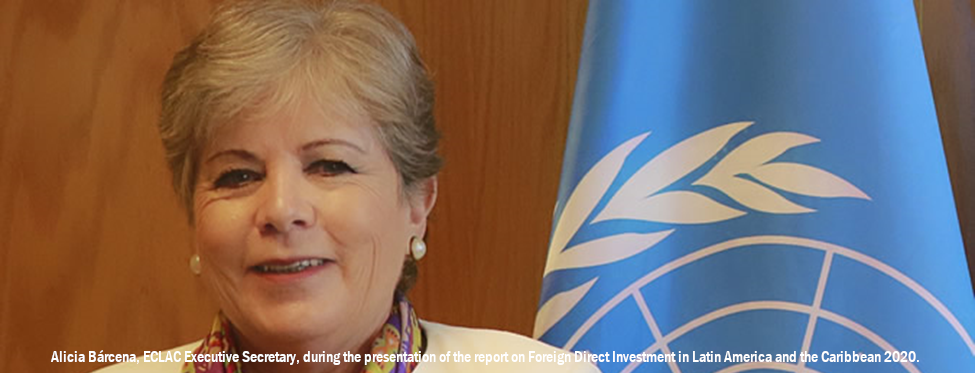The structural problems of Latin American and Caribbean economies and new international scenarios make it essential for FDI to contribute to driving development with equality and environmental sustainability in the region, ECLAC says in its annual report on this topic.
Latin America and the Caribbean received $160.721 billion dollars in Foreign Direct Investment in 2019, 7.8% less than in 2018, a decline that is seen intensifying sharply in 2020 when inflows are forecast to drop by between 45% and 55% as a result of the crisis stemming from the COVID-19 pandemic, the Economic Commission for Latin America and the Caribbean (ECLAC) advised today upon presenting its annual study Foreign Direct Investment in Latin America and the Caribbean 2020 (the document will be soon available on ECLAC’s website).
Worldwide, the amount of Foreign Direct Investment (FDI) is seen shrinking by 40% in 2020 and by between 5% and 10% in 2021. Thus, FDI would mark in 2021 its lowest value since 2005. Latin America and the Caribbean is the region forecast to have the steepest decline, according to the document by ECLAC launched at a virtual press conference by the United Nations regional organization’s Executive Secretary, Alicia Bárcena.
Since 2012, when a historic high was reached, foreign investment flows have experienced a nearly uninterrupted decline in Latin America and the Caribbean, which has demonstrated – primarily in South American countries – the relationship existing in the region between FDI flows, the macroeconomic cycle and commodity price cycles, the report sustains.
As in prior years, the study points to great heterogeneity in national results and no subregional pattern emerges: in 17 countries, inflows declined in 2019 versus 2018 while in 9 others, they increased. In 2019, the five countries that received the most investment were Brazil (43% of the total), Mexico (18%), Colombia (9%), Chile (7%) and Peru (6%).
In Central America, FDI inflows only grew in Panama and Guatemala. In the Caribbean, the FDI going to the Dominican Republic overcame the decline from the year before; Trinidad and Tobago had positive levels of investment after three years of negative growth; and in Guyana, as in 2018, there was a very significant year-on-year increase, fueled by investment in hydrocarbons exploitation and related sectors, positioning the country as the second-largest FDI recipient in the subregion.
Upon analyzing the 2010-2019 period, Europe consolidated its status as the most important investor in the region, followed by the United States. Intraregional investments, meanwhile, fell from 12% to 6%.
On another note, the report highlights that of all sectors, renewable energy accounted for the greatest number of project announcements in the last five years.
With regard to the performance of Latin American transnational corporations, known as translatinas, ECLAC’s publication records a 75% increase in FDI outflows from the region in 2019. However, upon examining the 2010-2019 decade as a whole, it can be seen that Latin American investment has lost steam, according to the Commission.
“The contributions that FDI has made in the region have been relevant, as a complement to national investment and a source of new capital, as well as for expanding export-related activities and developing the automotive industry, telecommunications, some segments of the digital economy and also sectors that have acquired strategic importance today in the context of the COVID-19 pandemic, such as the pharmaceutical industry and that of medical devices,” the study indicates.
However, the structural problems of the region’s economies and new international scenarios also make it necessary for FDI and the policies that seek to promote it to be part of a broader project that drives a progressive structural change, meaning a change that would allow for increasing productivity and achieving social inclusion, equality and environmental sustainability, ECLAC underscores.
“The FDI received by Latin America and the Caribbean has not catalyzed relevant changes in the region’s productive structure, largely because the policies to attract these flows have not been articulated with those focused on productive development. FDI offers major opportunities to move towards a new sustainable economy,” Alicia Bárcena emphasized. “It is urgently necessary to restore the role of industrial policies as an instrument for transforming the region’s productive structure.”
The senior official recalled that ECLAC has identified seven dynamic sectors that have a strategic role to play because they promote a technical shift, create jobs and reduce external constraints and the environmental footprint. These sectors, which could be bolstered by FDI, are: the transformation of the energy matrix based on renewable energy; sustainable mobility and urban spaces; the digital revolution for sustainability; the health-care manufacturing industry; the bioeconomy, meaning sustainability based on biological resources and natural ecosystems; the circular economy; and sustainable tourism.
In the second chapter of the report, entitled “Towards a new, post-pandemic global productive geography: The reorganization of global value chains,” ECLAC outlines as challenges for the region, containing the pressure for relocating nationally (reshoring) in the United States, seizing opportunities for relocation that would allow for strengthening regional productive systems (nearshoring), and articulating strategies to attract FDI with industrial policies in order to create local capacities.
Finally, the third chapter indicates that Latin America and the Caribbean has achieved a good position in terms of exporting medical devices, driven precisely by transnational corporations, with Mexico, Costa Rica and the Dominican Republic particularly standing out.
“In Latin America and the Caribbean, the COVID-19 crisis shows the growing importance of stimulating regional cooperation and the development of a regional health-care and medical devices market and of cross-border industrial centers. The medical devices industry requires manufacturing, scientific and technological capacities that are present in several countries in the region, the potential of which was revealed amid the health emergency. The development of national industrial and technological capacities and improved access to medical devices for the inhabitants of Latin America and the Caribbean is a strategic challenge, and to successfully tackle it, national and regional policy guidelines will be needed,” the document concludes.



 This information will never be shared to third parties
This information will never be shared to third parties